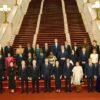Web Desk: International Day for the Eradication of Poverty is being observed across the globe today.
Theme for the day this year is “decent work and social protection, putting dignity in practice for all”.
We are halfway to the deadline set by the 2030 Agenda and the Sustainable Development Goals, our best and only chance of leaving the world better than we found it.
While decades of progress have lifted more than a billion people out of poverty, COVID-19 and a series of geopolitical shocks have resulted in serious setbacks. But there’s still time to finish strong—if we course correct.
Poverty isn't just about income 💵.
— UN Development (@UNDP) October 17, 2023
It's also about access to basic needs:
📚 Education
🏠 Shelter
🍎 Food
🏥 Healthcare
💧 Clean water
We can #EndPoverty and build a more sustainable 🌎 for all. https://t.co/pMAidgdVSQ pic.twitter.com/TyZQj6v67b
SDG 1, eliminating poverty in all its forms, is the all-access key.
This year, as we mark the International Day for the Eradication of Poverty, we look at what poverty tells us about the state of the world and what it means for human dignity, and with a focus on quality jobs.
But first, let’s strip ‘no poverty’—the bedrock of all the SDGs—down to its basics.
“What IS poverty in all its forms?”
Poverty isn’t just lack of money. It’s a trap. It’s poor health, sub-standard or no education, and lack of political power.
It’s dangerous – it often comes with unsafe housing and perilous working conditions.
It’s unfair. The poor aren’t treated equally under justice systems and their healthcare is inferior.
Poverty steals dignity and hope. It deprives us of one of our most basic desires—to see our children have a better life.
Achim Steiner one of the United Nation Development Program (UNDP) administrator in his write up apprised the situation of the poverty and efforts to put an end to it.
Our global community’s efforts to provide people with the means to untether themselves from the scourge of poverty has led to remarkable inroads. For instance, the share of the world’s workers living in extreme poverty was cut in half: from 14.3% in 2010 to 7.1% in 2019. Yet for one out of five global workers, a job is no guarantee of decent living conditions: some 630 million people are still considered as ‘working poor’. Indeed, the COVID-19 pandemic has reversed recent positive trends, subsequently exacerbated by a devastating cost-of-living crisis that has tipped millions of people into poverty worldwide. If current projections hold, an estimated 7% of the global population will still be living in extreme poverty by the end of this decade. How then, can we actively shape alternative futures?
-First, countries must set the conditions to create decent jobs in cooperation with the private sector that creates some 90% of jobs in developing countries. In particular, a focus on inclusive growth, jobs and poverty reduction must be reconciled with decarbonization and a just energy transition. That is amongst the key messages of the United Nations Development Programme’s (UNDP) new SDG Insights Reports that provide real-world examples of countries such as Iraq, which is diversifying its economy by boosting employment opportunities away from fossil fuels to pursue development in a greener, more inclusive manner. Women are also a focus of UNDP support. Whether it’s supporting alternative energy grids in sub-Saharan Africa or seabuckthorn berry harvesting in the Himalayas, UNDP is creating conditions to ensure that women have the skills and resources to build their own wealth.
-Second, countries must have the means to extend vital support to people experiencing poverty. Analysis by UNDP found that some 165 million people fell into poverty between 2020 to 2023 as debt servicing crowded out expenditures in critical areas like social protection, health, and education. Low-income countries are likely, on average, to allocate more than twice as much funding to servicing net interest payments as they do to social assistance. Yet solutions such as UNDP’s proposal for a Debt-Poverty Pause could mitigate this surge of poverty and lift out of it the 165 million people living on less than $3.65 a day. The estimated cost is approximately $14 billion or a meagre 0.009% of global gross domestic product (GDP) in 2022.
-Third, there is a need to go beyond GDP and design the metrics of the future if we are to truly tackle the root causes of poverty and advance progress across the Global Goals. We must leverage a range of data and not merely categorize people as ‘poor’ or ‘not poor’ dependent on whether they earn $2.15 per day. Rather, there is a need to examine the intersectionality of deprivations: recurring patterns of poverty that commonly impact the day-to-day lives of people globally to better tackle it. Indeed, beyond GDP is one of the central reform agenda items for the Summit of the Future in 2024 — an area where the United Nations (UN) is advancing the global thinking, informed by the human development approach.
As part of the UN family, UNDP is committed to push new boundaries to consign poverty to history. That is an approach rooted in dignity where people take more precedence over profit.
Achim Steiner, Administrator, United Nations Development Programme (UNDP)



